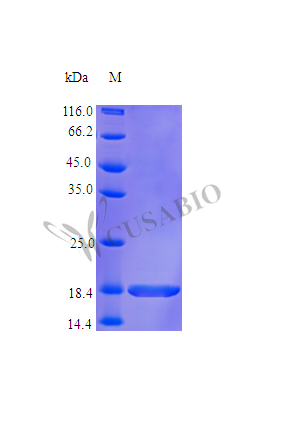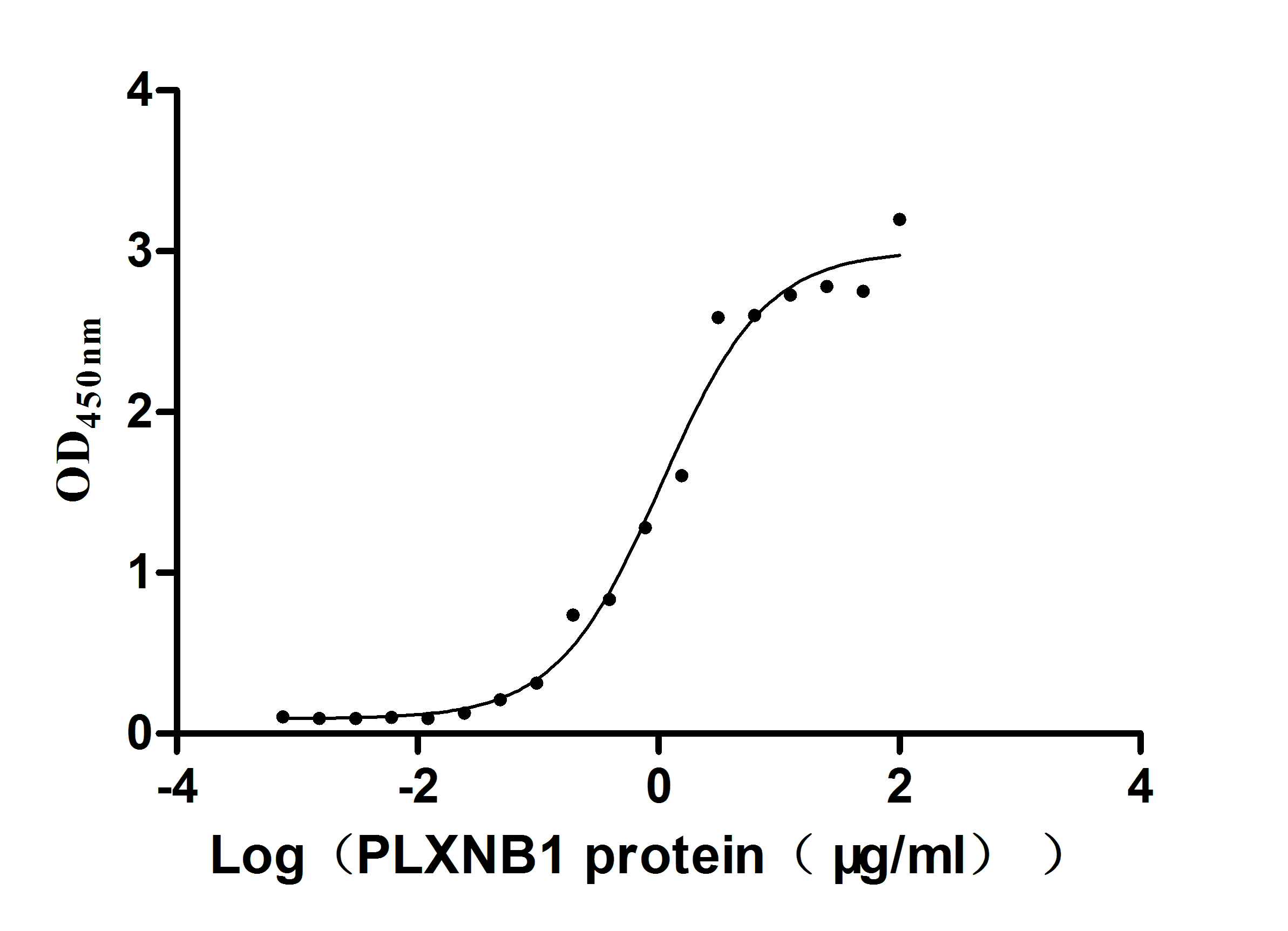Recombinant Human Fibroblast growth factor 10 protein (FGF10), partial (Active)
In Stock产品详情
-
纯度:>97% as determined by SDS-PAGE.
-
内毒素:Less than 1.0 EU/μg as determined by LAL method.
-
生物活性:Fully biologically active when compared to standard. The ED50 as determined by thymidine uptake assay using FGF-receptors transfected BaF3 cells is less than 0.5 ng/ml, corresponding to a specific activity of >2.0x106 IU/mg.
-
基因名:
-
Uniprot No.:
-
别名:BB213776 ; fd11d03; FGF 10; FGF-10; FGF10; FGF10_HUMAN; Fibroblast growth factor 10; Keratinocyte growth factor 2; KGF 2; Produced by fibroblasts of urinary bladder lamina propria; wu:fd11d03; zgc:109774
-
种属:Homo sapiens (Human)
-
蛋白长度:Partial
-
来源:E.Coli
-
分子量:19.1 kDa
-
表达区域:40-208aa
-
氨基酸序列LGQDMVSPEA TNSSSSSFSS PSSAGRHVRS YNHLQGDVRW RKLFSFTKYF LKIEKNGKVS GTKKENCPYS ILEITSVEIG VVAVKAINSN YYLAMNKKGK LYGSKEFNND CKLKERIEEN GYNTYASFNW QHNGRQMYVA LNGKGAPRRG QKTRRKNTSA HFLPMVVHS
-
蛋白标签:Tag-Free
-
产品提供形式:Liquid or Lyophilized powder
Note: We will preferentially ship the format that we have in stock, however, if you have any special requirement for the format, please remark your requirement when placing the order, we will prepare according to your demand. -
缓冲液:0.2 μm filtered 2 x PBS, pH 7.4 ,lyophilized
-
储存条件:Store at -20°C/-80°C upon receipt, aliquoting is necessary for mutiple use. Avoid repeated freeze-thaw cycles.
-
保质期:The shelf life is related to many factors, storage state, buffer ingredients, storage temperature and the stability of the protein itself.
Generally, the shelf life of liquid form is 6 months at -20°C/-80°C. The shelf life of lyophilized form is 12 months at -20°C/-80°C. -
货期:5-10 business days
-
Datasheet & COA:Please contact us to get it.
相关产品
靶点详情
-
功能:Plays an important role in the regulation of embryonic development, cell proliferation and cell differentiation. Required for normal branching morphogenesis. May play a role in wound healing.
-
基因功能参考文献:
- We report the ophthalmological and genetic study of a 19-year-old woman and her relatives suffering from this syndrome. A new probably pathogenic variant is described in the FGF10 gene. PMID: 29053399
- We have revealed significant association of FGFR2 and MAP3K1 polymorphisms with breast cancer. PMID: 29372690
- data suggest that the strongest signal of association at 5p12 is mediated through coordinated activation of FGF10 and MRPS30, two candidate genes for breast cancer pathogenesis PMID: 27640304
- Fgf10 signaling has an essential role in the formation of lipofibroblasts during late lung development PMID: 26511927
- Expression of Fibroblast Growth Factor 10 is correlated with poor prognosis in gastric adenocarcinoma. PMID: 26268776
- FGF10 has a role in protecting neuron against oxygen-glucose deprivation injury through inducing heme oxygenase-1 PMID: 25446127
- Data identify autocrine activation of FGF signaling as an essential mechanism in promoting Pten-deficient skin tumors. PMID: 24582960
- The therapeutic potential of the FGF10 treatment. PMID: 24865969
- FGF10 plays an important role for tumor growth by both paracrine and autocrine manner. PMID: 24320134
- The findings show that immunohistochemistry with FGF10, FGFR2b, or SHH could be useful in differentiating CCAM from type I PPB, when a child presents with a focal cystic lung lesion. PMID: 24004862
- Paracrine FGF10 signaling stimulates the differentiation of human stem cell into urothelial cells. PMID: 23949743
- High FGF10 expression is associated with ameloblastoma. PMID: 24002438
- Three FGF10 single nucleotide polymorphisms in complete linkage disequilibrium--rs339501, rs12517396, and rs10462070--were associated with extreme myopia in the Japanese population. PMID: 24265547
- FGF-10 expression during the development of the human hindgut and anorectum suggests that it may play a role in hindgut and anorectal morphogenesis. PMID: 23774963
- The sclera of myopic eyes had higher FGF10 levels. The risk G allele of SNP rs339501 was associated with extreme myopia in human and caused a higher gene expression in the luciferase assay. PMID: 23599340
- the posttranslational and transcriptional mechanisms underlying stimulation of P-glycoprotein function and expression by keratinocyte growth factor-2 (KGF2) that may contribute to the beneficial effects of KGF2 in intestinal inflammatory disorders PMID: 23328208
- tooth agenesis had increased risk of a family history of cancer. tooth agenesis was associated with positive self-reported family history of cancer and variants in FGF10. PMID: 23169889
- Identification of FGF-10 at both protein and mRNA levels in ovaries from fetuses, girls, and women suggests that FGF-10 contributes to preantral follicle development; FGF-10 is expressed in both granulosa cells and oocytes. PMID: 22877940
- Our data suggest that common variants in FGF10 increase the risk for a wide range of non-syndromic limb deficiencies. PMID: 22965740
- [review] FGF10 mediates biological responses by activating FGF receptor 2b (FGFR2b) in a paracrine manner. PMID: 21696361
- The relationship between human ISL1 and FGF10 within the embryonic time window during which the linear heart tube remodels into four chambers, was examined. PMID: 22303449
- Investigation of the pulmonary functions of COPD patients heterozygous for loss of function mutations in the FGF10 gene was performed. The patients show a significant decrease in lung function parameters when compared to control values. PMID: 21742743
- Gremlin-mediated BMP inhibition results in activation of epithelial cells and transient fibrosis, but also induction of epithelium-protective FGF10 PMID: 20705941
- FGF2 and FGF10 regulate migratory activity of ovine trophoblast cells through MAPK-dependent pathways. PMID: 21310815
- FGF10 can promote the adipogenesis effect in situ. PMID: 19915940
- There was no association among gene FGFR1 rs13317, p. E467K, p. M369I, p. S393S and gene FGF10 rs1448037 and nonsyndromic cleft lip with or without palate in Chinese population. PMID: 19727229
- These results suggested that Thr-114 is a crucial functional residue for FGF10, and mutating Thr-114 to Ala or Arg would lead to great decrease in receptor-binding affinity and biological activity of FGF10. PMID: 20036575
- FGF10 upregulates Na(+)-K(+)-exchanging ATPase via the MAPK pathway. PMID: 12804770
- FGF-10 attenuates H2O2-induced alveolar epithelium DNA damage by mechanisms that involve activation of Grb2-SOS/Ras/RAF-1/ERK1/2 pathway and DNA repair. PMID: 14975937
- Fgf10 mRNA is overexpressed in a subset of human breast carcinomas. PMID: 15208658
- Data validate the symmetric two-end model of fibroblast growth factor (FGF) receptor (FGFR) dimerization and FGF binding and argue against the asymmetric model of FGFR dimerization. PMID: 15632068
- We suggest that haploinsufficiency for FGF10 during a crucial stage of development results in ALSG. PMID: 15654336
- Human embryonic pancreatic mesenchyme expresses FGF10, which might be used used to expand human embryonic pancreatic epithelial cells. PMID: 15690149
- Human recombinant FGF10 maintains murine Notch activation and induces the expansion of murine pancreatic precursors while blocking their differentiation. PMID: 16323074
- Localization of the FGF-10 receptor to the urothelial layer is clinically significant because intravesical administration of FGF-10 may provide a means to control the turnover of transitional epithelium in bladder disorders such as interstitial cystitis. PMID: 16597614
- Activation of Toll-like receptor 2 (TLR2) or Toll-like receptor 4 (TLR4) inhibited FGF-10 expression, leading to abnormal saccular airway morphogenesis. PMID: 17071719
- R80S and G138E mutations are associated with aplasia of the lacrimal and salivary glands. PMID: 17213838
- a nuclear localization signal-like motif of FGF-10 is a partial determinant of its intracellular distribution and is necessary for its mitogenic activity PMID: 17471512
- Trophoblast outgrowth and invasion (part of placental villi sprouting) at the fetal maternal interface is in part under delicate control of FGF 10 and Sprouty 2. PMID: 17496316
- Results suggest that Lacrimo-auriculo-dento-digital syndrome is caused by reduced activity of the fibroblast growth factor 10 (FGF10)-FGF receptor 2 signaling pathway. PMID: 17682060
- Expression in diverse niches of adult brain of Fgf10-lacZ reporter mice implicates Fgf10 in control of neurogenesis and/or conservation of neurogenic potential. PMID: 18329286
- It cannot be ruled out that other genes involved in the signalling pathway of FGF10 may contribute to the formation of these congenital malformations. PMID: 18587586
- Stromal FGF10 induces migration and invasion in pancreatic cancer cells through interaction with FGFR2, resulting in a poor prognosis. PMID: 18594526
- family-based approach revealed an intronic variation of the FGF10 gene causing aplasia of lacrimal and salivary glands-syndrome PMID: 19102732
- Disruption of localized pattern of mesenchymal fibroblast growth factor 10 expression results in impairment of lung branching morphogenesis, which progresses to emphysematous airspaces in adults. PMID: 19115389
- Fgf10 is a strong causative candidate for defects observed in Apert syndrome since its genetic knockdown in a mouse model of Apert syndrome results in the rescue of the skeletal and visceral defects associated with this congenital disease. PMID: 18773495
- An analysis of the distribution and fate of Fgf10-expressing cells in the adult mouse brain suggests that Fgf10 may have critical regulatory roles in stem cell function and generation of new neurons in diverse areas of the adult brain. PMID: 18773495
- TGFbeta1 caused a rapid and transient decrease in Fgf10 mRNA levels in primary prostatic cells. Deletion analysis of the Fgf10 promoter identified a region that mediated a proportion of promoter activity as well as promoter down-regulation by TGFbeta1. PMID: 14726452
显示更多
收起更多
-
相关疾病:Aplasia of lacrimal and salivary glands (ALSG); Lacrimo-auriculo-dento-digital syndrome (LADDS)
-
亚细胞定位:Secreted.
-
蛋白家族:Heparin-binding growth factors family
-
数据库链接:
HGNC: 3666
OMIM: 149730
KEGG: hsa:2255
STRING: 9606.ENSP00000264664
UniGene: Hs.248049
Most popular with customers
-
Recombinant Human Plexin-B1 (PLXNB1), partial (Active)
Express system: Mammalian cell
Species: Homo sapiens (Human)
-
Recombinant Human E3 ubiquitin-protein ligase ZNRF3 (ZNRF3), partial (Active)
Express system: Mammalian cell
Species: Homo sapiens (Human)
-
Recombinant Macaca fascicularis CD93 molecule (CD93), partial (Active)
Express system: Mammalian cell
Species: Macaca fascicularis (Crab-eating macaque) (Cynomolgus monkey)
-
Recombinant Human Cell adhesion molecule 1 (CADM1), partial (Active)
Express system: Mammalian cell
Species: Homo sapiens (Human)
-
Recombinant Human Transmembrane 4 L6 family member 1(TM4SF1)-VLPs (Active)
Express system: Mammalian cell
Species: Homo sapiens (Human)
-
Recombinant Macaca fascicularis Cadherin 6(CDH6),partial (Active)
Express system: Mammalian cell
Species: Macaca fascicularis (Crab-eating macaque) (Cynomolgus monkey)
-
Recombinant Human Interleukin-1 receptor accessory protein (IL1RAP), partial (Active)
Express system: Mammalian cell
Species: Homo sapiens (Human)




















